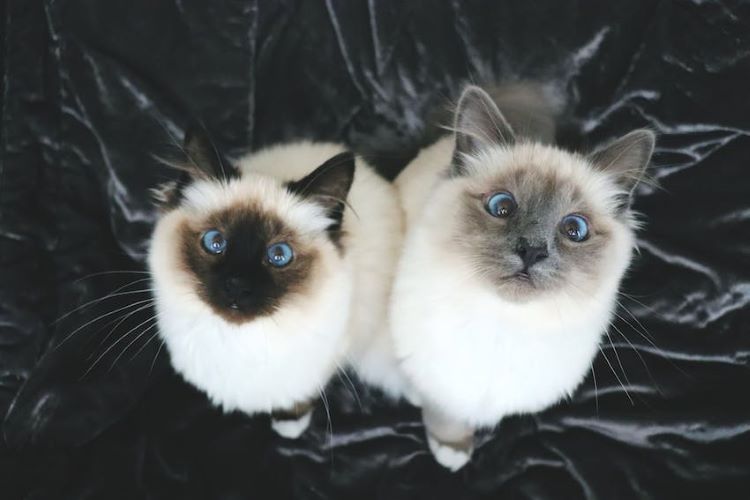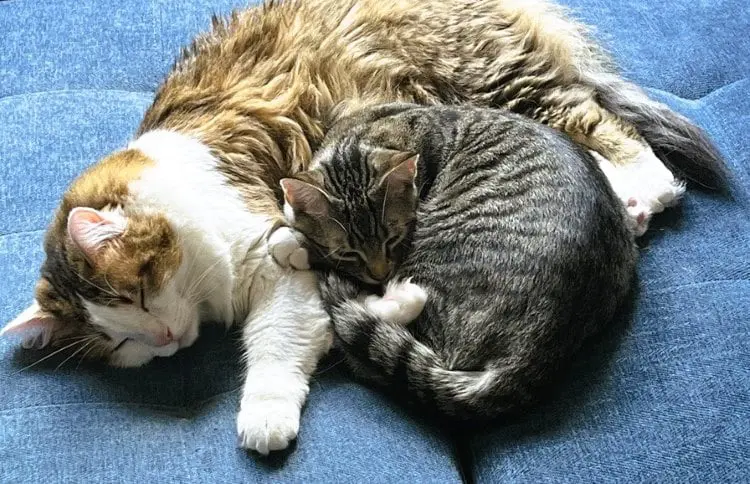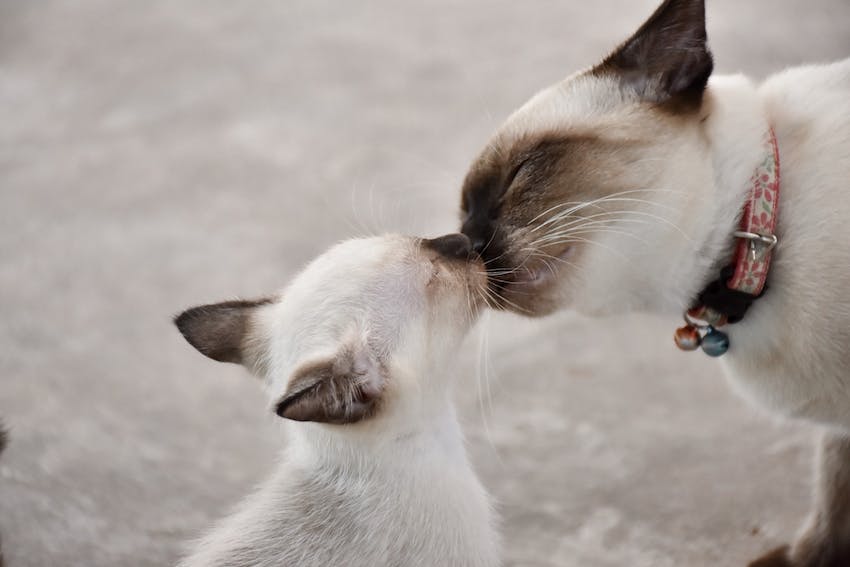Ready to help treat your pet to a healthy life?
How to Tell if Cats are Bonded to Each Other
By : Sam Chambers | Published Feb 6, 2024

As independent creatures, cats often exude an air of mystery and aloofness. It’s therefore easy to assume that cats prefer solitude over companionship, but don’t be fooled by their too-cool-for-school act. Beneath the surface, our feline friends are capable of forming deep, meaningful bonds with humans and other pets alike. But how can you tell when cats are bonded with each other?
Bonded cats in particular share a unique relationship that goes beyond mere cohabitation or a mutual dislike for bath time. Cat bonds involve a profound sense of trust, harmony, and often, a silent language that only they understand. Being able to recognize bonding in cats is important for maintaining safe pet environments and avoiding unnecessary drama.
So, if you've ever wondered how to tell if cats are bonded with each other and how you can help your own cats bond, buckle up for a journey into the heartwarming realm of feline friendship.
6 signs of bonding between cats
Whether you adopted a pair of kittens or recently welcomed a second cat into your home, understanding the signs of bonding in cats will help you witness the meaningful connection between bonded cats. From mutual grooming to synchronized behavior, here’s how you can identify a bonded pair of cats.
1. Mutual grooming
One of the most unmistakable signs of bonding in cats is mutual grooming. Bonded cats engage in this behavior not only for hygiene but as a form of socialization. If you notice your cats grooming each other and helping with hard-to-reach areas, it's a clear sign that they’ve developed a deep level of trust and comfort in their relationship.
2. Sleeping and napping together
Cats are creatures of habit, so their sleeping arrangements provide valuable insights into their feline mystique. Bonded cats often sleep in the same space or cuddle up together, finding comfort and security in each other’s presence. If you spot your cats regularly napping together, it’s a good sign that they’re bonded!
3. Playing together
Playtime isn’t just for kittens. Bonded cats often engage in mutual social play, meaning both cats enjoy and participate equally in playful activities like chasing, pouncing, and wrestling. However, if one cat is often the aggressor when chasing or wrestling, or there are long breaks between playing and lots vocalization, this might indicate that their interactions are more contentious than playful.
If two cats actively engage in true mutual social play with each other, their connection is likely a very strong and positive one. And while playful interactions can serve as both entertainment and socialization, studies show that playful cats are happier and have a better quality of life.
4. Shared territory
Since cats are inherently territorial, they commonly mark their territory as a way of establishing boundaries. Cats transfer their natural pheromones using scent glands in their face and head, so they mark their territory by rubbing against furniture, walls, and even people. They’ll fight to defend what they believe is their territory, which is the common culprit behind most catfights.
That said, bonded cats tend to share their territory without conflict or aggression. Bonded cats find comfort in each other’s presence, so they feel safe occupying the same spaces. They might even join forces and defend their territory together! If your cats happily share common spaces and resources with each other, this is an indicator of a harmonious relationship.
5. Synchronized behavior
Watch closely, and you might catch a bonded pair of cats engaging in similar activities at the same time. This could include simultaneous grooming sessions, synchronized meowing or blinking, rubbing against one another, and touching tails. Bonded cats synchronize their behavior to strengthen their bond, create a sense of unity, and relieve stress.
6. Separation anxiety
Over time, bonded cats develop a mutual dependency on each other. As such, it’s possible for a pair of bonded cats to experience some distress when apart. Cats who become agitated, vocal, or anxious when separated likely just miss each other! As heartbreaking as it might be to listen to your cat call out for their missing friend, this behavior is a testament to their strong bond.
How long does it take for cats to bond?
Every cat is unique, so the timeline for cats to bond can vary and may take some time. It’s also worth noting that not all cats are capable of bonding. Their individual personalities, past experiences, and environment all influence whether two cats bond with one another.
While some cats can establish a connection almost immediately, others might take weeks or even months. Two kittens, for example, may bond faster than two adult cats. An adult cat and a kitten may go either way, depending on the older cat's personality and past experiences with other felines (especially kittens).
Patience is key when it comes to encouraging bonding between cats. Rushing the bonding process could potentially cause more harm than good, leading to stress and stronger resistance for both parties. Even if you've had a bonded pair of cats before, their relationship may not be the same as others. Stay calm and patient, and allow things to progress naturally.

How to help cats bond
Bonded cats certainly make life easier, but as a cat owner, there’s only so much you can do to help your cats bond. If you want to foster a lasting, meaningful relationship between your two cats, it's essential to respect each cat's pace and allow the relationship to develop organically. It’s also crucial to properly introduce two pets if you want to give them the best chance at bonding.
Encouraging your cats to play together and interact respectfully with each other, all within a comfortable and safe environment, can help them bond. Look for positive signs that your cats are starting to bond, such as mutual grooming and peaceful coexistence. If you catch your cats grooming each other or peacefully napping side by side, know that you're witnessing the start of a beautiful feline friendship!
Signs cats aren’t bonding
While we all hope for harmonious relationships between our feline friends, it’s important to recognize the signs that your cats aren’t getting along. Look for signs such as:
- Aggressive and violent behavior
- Avoidance and hiding
- Flattened ears, arched backs, or stiff tail
- Spraying or urine marking
- Increased or decreased grooming habits
- Excessive vocalization
- Resource guarding
- Tension during mealtime
- Sudden changes in behavior
- Lack of play or interaction
Recognizing these signs early on will help you address any issues and improve the relationship between your cats. At times, you may need to draw boundaries between your cats to support the bonding process. Make sure to provide separate spaces for each cat, supervise early interactions, and consult a veterinarian or animal behaviorist for advice.
If your cats suddenly start fighting or acting aggressive, consider taking them to the vet. A change in a cat’s behavior is often an early indicator of pain or discomfort.

Always keep bonded cats together
Once two cats have bonded, separating them could have profoundly negative effects on their wellbeing and emotional health. Cats thrive on the companionship and familiarity of their bonded partner, and separating a bonded pair could lead to stress, anxiety, depression, and behavioral issues. Some shelters even require that a bonded pair of cats get adopted together due to their special connection.
Make safety a priority
As a cat owner, it’s important to foster an environment where your cat can thrive socially, emotionally, and physically. However, even the safest homes aren’t a guarantee that surprise accidents or illnesses won’t happen. Having cat insurance is one of the best ways to protect their health and happiness — as well as your finances.
Whether you have a pair of cats who’ve been together since birth, or you've recently introduced a new cat to the family, prioritizing their wellbeing can add a deeper layer to the joy of pet ownership.
